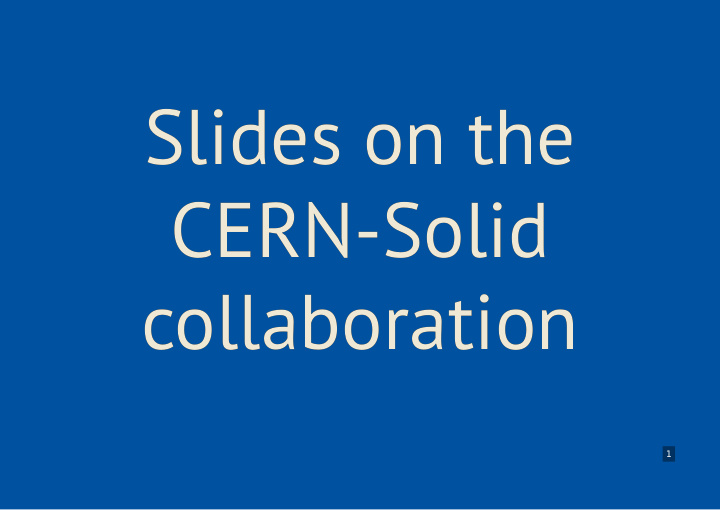



Slides on the Slides on the CERN-Solid CERN-Solid collaboration collaboration 1
The CERN-Solid collaboration The CERN-Solid collaboration Presentation at the Open Search SYMposium (OSSYM) 2020/10/12 Event details Maria Dimou – CERN-Solid collaboration manager with contributions from CERN web application developers and Jan Schill - MSc student in the CERN-Solid code investigation project . 2
World Wide Web - What World Wide Web - What happened happened The Web was invented at CERN by Sir Tim Berners-Lee (TimBL) in 1989. He defined it as a free, open, networked Internet application . The Web produced an uprecedented change to human civilisation. 30 years later, the original purpose of the Web “access to knowledge, free for all and respecting each one” is being violated. TimBL proposed Solid , the open source platform aims to give people control over their data. 3
The first ten years The first ten years TimBL went to MIT to create the World Wide Web Consortium (W3C) in 1994. In the CERN Web Office , till 1999 we: ran TimBL’s httpd - followed by the Apache web server with virtual hosting, on Unix platforms. negotiated a free-of-charge Netscape browser support contract. deployed pinaweb (Personal Intelligent Newspaper Agent) (a web profile by CERN student Heidi Schuster). investigated Web-based calendars recommended HyperNews for collaborative work and more… 4
Web Search at CERN Web Search at CERN CERN student Darius Kogut wrote Torch , a search engine parsing natural english language in 1998. This development was an intellectual satisfaction; relationship with other disciplines, the understanding of rich human language by the search engine. As the Web was in exponential growth, we couldn’t go far with in- house development. So we evaluated Lycos and Altavista… they left a lot to desire. Finally we signed a negligeable-charge contract with Infoseek , then Inktomi . Slides from 1999 5
Web Search in general Web Search in general Search was “innocent” at the time; companies didn’t make money out of offering, withholding, manipulating information on the web. Google didn’t exist yet. The search results were irrelevant or incomplete, still they were what existed and not what the engine would like to show the user. Surveillance and intrusion were not yet terms we were conscious of. 6
CERN & Web standardisation since the year CERN & Web standardisation since the year 2000 2000 Computing focus at CERN was turned to the huge amount of data produced at the LHC. Proposals for a CERN-W3C collaboration remained without answer for 25 years. The suggestions were: to combine use of the https protocol for physics’ data transfer and remote access to storage with W3C standardisation work. Details . to contribute design concepts in CERN applications in areas like the Data Catalogue Vocabulary, cross-service inter- operability and Authentication/Authorisation rules and restrictions. Details . 7
Solid - What is Solid - What is TimBL announced the Solid project (Social Linked Data) in 2016, aiming to give people control over their data. His summary: This is an open source platform, adding standards never put into the original web spec, including: Global single sign-on, Universal access control A universal data API so that any app can store data in any storage place. Socially, Solid is a movement towards a world in which users are in control, and empowered by large amounts of data, private, shared, and public. 8
CERN-Solid collaboration - born this year CERN-Solid collaboration - born this year 2020. 2020. CERN packages relevant to Solid spec’s for evaluation: The CERN push notifications , unilateral, via subscription and archived. Indico , an event management open source platform, with 20 years of operational status. CS3MESH , a pan-European cross-institution mesh that will offer data sharing/co-editing facilities, relying on the federation of different sites by using well-known APIs. InvenioRDM , a Research Data Management, open source platform for persistent registration of research papers and data. The new CERN Authentication project. Web pages of the above in the “References” at the end. 9
Activities now Activities now MSc student Jan Schill from https://itu.dk started working on this project . Goals include: 1. understanding which Solid specifications are ready and clear. 2. evaluating the first Solid implementations. 3. making a recommendation to the CERN open source applications on Solid adoption (or not). 4. exploring Indico, to test the Solid principles, by: modifying-ala-Solid the Indico registration form module, so that registration data belong to the user and not to Indico. enriching Indico meeting pages with Solid-based content, such as comments. Indico-related suggestions by TimBL and Pedro Ferreira . 10
Search-related work in Solid Search-related work in Solid In Solid, data is stored in Pods . Current and planned work in Solid includes: 1. The ‘Search UI’ item in TimBL’s roadmap (next slide) - client-side interface, for searching in one’s own pod. 2. Server-side pod-wide search functionality by Fred Gibson for the TrinPod implementation of a Solid server. 3. Solid-user-search for searching a person (like in a phonebook) 4. hashtag-search, for content that is related to a given hashtag. For design details and development status contact Michiel de Jong . 11
Solid (evolving) roadmap Solid (evolving) roadmap 12
References I References I [1] The original Web proposal https://www.w3.org/History /1989/proposal.html [2] The CERN-Solid Indico category https://indico.cern.ch/category /11962/ [3] The Solid project web site https://solidproject.org [4] The CERN Web Office (most data missing today) https://weboffice.web.cern.ch/WebOffice/ [5] The CERN Torch search engine http://cern.ch/dimou /SApaper.html#torch [6] CERN-W3C 2014 proposal https://cern.ch/dimou/personal/CERN- W3C_Collaboration.pdf [7] CERN-W3C 2017 proposal https://cern.ch/dimou/personal/CERN- W3C_Collaboration_2017_proposal.pdf 13
References II References II [8] Push notifications archaeology - proposal in 2003 https://cern.ch /dimou/it-us/zephyr.shtml [9] Push notification proposal in 2020 https://codimd.web.cern.ch /p/ry5_j4r2U#/ [10] Linked Data Notifications: https://www.w3.org/TR/ldn/ [11] The WebSocket Protocol: https://tools.ietf.org/html/rfc6455 [12] Indico https://getindico.io/ [13] The Road to the new CERN Identification https://auth.docs.cern.ch/whitepapers/the-road-to-new-auth/ [14] CS3 MESH https://silo2.sciencedata.dk/sites/cs3mesh4eosc/ [15] InvenioRDM https://inveniosoftware.org/ 14
Recommend
More recommend